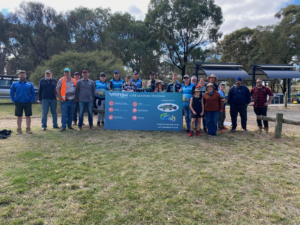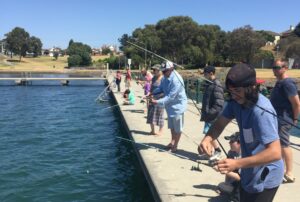July 3, 2017
By Rob Caune, VRFish Member (Gippsland Angling Association)
The magnificent Mitchell River of East Gippsland was listed as a Heritage River in 1992. It is the largest river without a dam in southeast Australia and, provides the Gippsland Lakes with 35 percent of its freshwater in flows. These in ows are vital to the health of the fishery and to the internationally listed wetlands of the Lakes.
Its major tributaries include the, Wonnangatta, Wongungurra, Dargo and Wentworth Rivers, which drain Victoria’s Southern Alps of the Great Dividing Range.
The river has a long estuary reach that starts upstream of Bairnsdale. Where it enters the Gippsland Lakes, the river has formed long finger like peninsulas that extend kilometres into the Lakes. These are known as the Silt Jetties. Reputably, one of the longest ‘finger-delta’ structures in the world.
In the last 100 years, the fishery and ecology of the Gippsland Lakes, as well as its river systems, have been enormously challenged by human development. The fishery was once unbelievably abundant. The estuary and freshwater reaches of the Mitchell River once teemed with Gippsland perch which was how, at the time, the Australian bass and estuary perch were collectively named.
The overwhelming observation during the first half of the last century, from fisheries inspectors and anglers alike, was that the freshwater Gippsland perch, now described as Australian bass, were no longer breeding.
So great was the local affection for the species that their alarming decline sparked significant outcry. Fisheries Victoria responded by requesting local angling clubs provide brood stock for a proposed breeding program. The first of these requests was made as early as 1911. These early captive breeding programs, however, were all unsuccessful.
Australian bass were subsequently listed as ‘rare’ by the Victorian Government and became largely unfamiliar to many Victorian fishers.
It was only early this century when Fisheries Victoria was able to source a reliable supply of Australian bass to stock East Gippsland Rivers. Financed entirely by revenue obtained through the sale of recreational fishing licences, the first restocking of the Mitchell River occurred in 2010.
I was contacted early last year by a friend who operates a walnut farm on the Wonnangatta River; an arm of the Mitchell River. An important part of his business plan is renting out his old homestead to recreational anglers. He was concerned, however, that a ‘new’ type of fish was living in his favourite swimming hole on his section of the river. He knew that they were not trout, as water temperatures at that time of the year were too warm. Trout are normally only present during the colder months.
To cut a long story short, a subsequent lure casting session revealed that these ‘new’ fish were 18-20 centimetre long Australian bass, and were in great condition as well as large in numbers. Earlier this year, Fisheries’ surveys of this part of the Mitchell catchment confirmed that large numbers of juvenile Australian bass were now present.
A new era had begun for the Mitchell River that only passed generations would have experienced.
The launch of the Target One Million Plan initiative by the Victorian Labour Government, which aims to get one million Victorians recreationally fishing, is now further underpinning the revival of the Mitchell River fishery. Headed by Craig Ingram, further bass stocking of the Mitchell River catchment is now planned. The Target One Million funding, together with money provided
by recreational anglers through their licence fees, will further consolidate the Australian bass’s return to this catchment.
The Mitchell River fishing economy could be described as having two significant sectors that currently attract visitations from recreational anglers. The most significant sector is the estuary section, which provides the famous black bream, estuary perch, mullet, and other estuarine species. The second sector is the alpine area that has a trout fishery. The reintroduction of Australian bass will economically reenergize the long middle section of the river system which currently has no viable fishery to attract visitations from anglers. The historic record shows that it was this section of the river, when bass were abundant, that local anglers greatly coveted.
During the next couple of years, as the first of these stocked bass become legal size, Gippslanders and all Victorians will be able to renew the relationship that their great, great, grandparents once enjoyed with Australian river bass.

Large female bass captured by East Gippsland recreational anglers for the Victorian bass breeding program.
The ideal circumstances for the Mitchell River would be to restore the ecological services of the catchment to enable the Australian bass to naturally breed. This idea is shared by recreational fishers as well as the broader community. However, the cost of doing so and the economic dislocation it could cause is enormous. It would involve shutting down ports, abandoning current flood mitigation schemes, and profoundly changing the local agriculture industry. There appears to be little political appetite to undertake such a large economic reorganisation.
However, recreational anglers, through their licence fees, are willing to pay for a breeding and stocking program to restore the Mitchell River’s Australian bass population and, therefore, create
a bass fishery for this important river. A key component of this strategy is to bring people back to the river and to allow them to be exposed to the magic of river bass fishing. If people enjoy and value something, then there is a greater likelihood that the river will be valued and cared for into the future.
Recreational anglers’ involvement in restoring the ecological values in the Mitchell River also includes other dimensions. Over the past ten years’, significant amounts of recreational licence fee money has been made available to the East Gippsland Catchment Management Authority to install woody habitat into the river.
The Mitchell River, like many other rivers, was systematically de-snagged to improve its navigability for water craft, which was of great detriment to fish habitat.
Woody habitat is an extremely important element in maintaining fish stocks in all river environments. With increased turbidity and nutrient runoff challenging aquatic vegetation, restoring the amount of woody habitat in the river system has never been more important than now. Woody habitat, like aquatic vegetation, increases the underwater surface area available for micro invertebrates to grow upon, thereby increasing the river’s food supply.
The recreational angler contribution to the Victorian economy is significant. Recent studies have indicated that it provides $2.3 billion in direct expenditure and 5,200 jobs. Revenue from taxes and licence fees that come from the recreational fishing economy has financed the restoration of many fish species and their environments. In many ways the Target One Million initiative, if successful, will increase the amount of financial resourcing and human commitment coming to the aid of fishes and the environment.
When recreational anglers buy a Victorian Recreational Fishing Licence they become a part of these great river restoration stories, such as the one that is currently unfolding on the Mitchell River. These are great achievements that recreational fishing licence holders are entitled to hear, be proud of, and have the Victorian community recognise.








